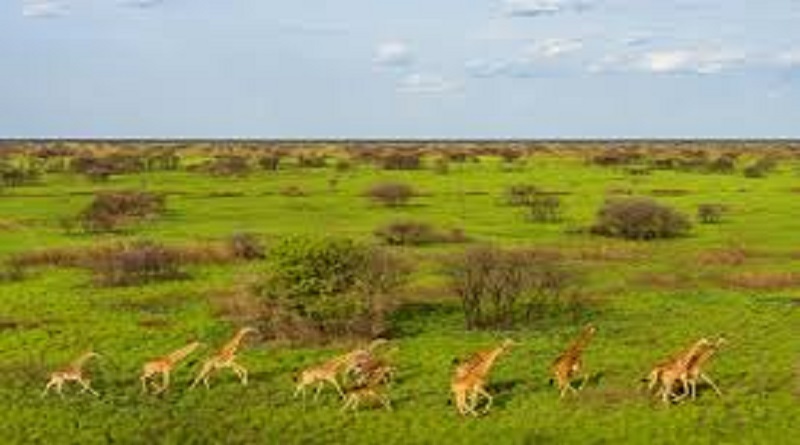New maps document world’s largest land animal migration across South Sudan, Ethiopia
New maps released on Wednesday 30 April 2025 document in unprecedented detail the seasonal movements of two migratory antelope species—the white-eared kob* and tiang—across South Sudan’s expansive wetlands and Ethiopia’s Gambella National Park. Covering an area of over 100,000 km², roughly seven times larger than Serengeti National Park, these maps reveal the largest known land mammal migration on Earth, also known as the “Great Nile Migration”.
Approximately five million kob and 400,000 tiang, alongside other hooved mammals also known as “ungulates,” undertake complex, long-distance journeys to access essential wet and dry-season habitats annually. Their routes take them between Badingilo and Boma National Parks in South Sudan. Some migrate further north to Gambella National Park in Ethiopia, an important dry-season refuge particularly for kob from February to May.
The newly released migration maps form part of the Atlas of Ungulate Migration, developed by the Global Initiative on Ungulate Migration (GIUM) under the Convention on the Conservation of Migratory Species of Wild Animals (CMS). Publicly available online, the atlas and the new maps aim to support conservation planning, infrastructure development, and policymaking to maintain critical ecological connectivity, thus preserving essential habitats for migratory species while reducing the potential for human-wildlife conflict.
“The detailed migration maps unveiled today highlight the interconnectedness of landscapes across South Sudan and Ethiopia and underscore the urgent need to balance infrastructure development with the survival of migratory species. They provide a powerful reminder of the importance of preserving these corridors for the health of ecosystems and thriving wildlife populations, as well as to reduce human-wildlife interactions,” says Amy Fraenkel, Executive Secretary of CMS.
The maps build upon recent aerial surveys and tracking data released in June 2024 by African Parks and South Sudan’s Ministry of Wildlife Conservation and Tourism. During these surveys, biologists estimated approximately 5–7 million migratory animals across four species — white-eared kob, tiang, Mongalla gazelle and Bohor reedbuck. For the kob, the maps significantly expand upon earlier tracking studies conducted by the Ethiopian Wildlife Conservation Authority (2013–2015), providing new insights into how migrations connect critical habitats across international boundaries.
“Seeing the full extent of these migrations is awe-inspiring, but also daunting,” says Kumara Wakjira, the Director General of the Ethiopian Wildlife Conservation Authority. “Although it will be challenging, we are committed to assuring that these landscapes remain protected to sustain the movement of kob and other migratory species in Ethiopia into the future.”
Migration routes for kob and tiang —now mapped clearly between seasonal ranges—highlight essential corridors needed for their survival through extreme seasonal conditions. As human populations and infrastructure expand, these detailed maps offer critical information to mitigate impacts of large-scale projects, particularly energy infrastructure.
Oil extraction poses a pressing concern, notably within a development area known as “Block B2”, operated by South Africa’s Strategic Fuel Fund (SFF) and South Sudan’s Nilepet, covering areas critical for both kob and tiang migrations. Without careful and informed planning, the oil exploration set to begin in 2025 could seriously disrupt wildlife migration, increase human encroachment, and escalate illegal hunting. The rising incidence of illegal tiang harvesting along roads already shows how essential it is to plan infrastructure with wildlife protection in mind.
“Humans and wildlife have shared this landscape since time immemorial, and even amidst new pressures, they can continue to do so,” says Grant Hopcraft, a member of the scientific advisory team of the GIUM, which led the migration analyses and mapping. “If used, these migration maps based on the best available science are important tools in ensuring that the needs of both wildlife and humans are balanced.”
In South Sudan, conservation based on sound management and collaboration with local communities is urgently needed. Increasing illegal wildlife trade and the potential impacts of petroleum extraction highlight the importance of safeguarding the region’s migratory wildlife. South Sudan and Ethiopia have a unique opportunity to preserve one of the world’s most remarkable natural phenomena for future generations, potentially leveraging conservation and tourism for sustainable economic growth.
“We are dedicated to conserving and studying the migrations here in South Sudan, which are not only globally significant but part of our national identity,” says Malik Morjan, professor of wildlife biology at the University of Juba, South Sudan, and a key contributor of data for the maps.
This work to map the migrations of these species is contributing to the broader mandate under CMS to address ecological connectivity. At the 14th Meeting of the Conference of the Parties, the Global Partnership on Ecological Connectivity was launched to support the scaling-up of global efforts to restore and conserve ecological connectivity, which is essential for migratory species, and vital for healthy ecosystems. Conserving migratory species and ensuring that spectacular wildlife movements continue into the future directly supports the achievement of key global commitments such as the Kunming-Montreal Global Biodiversity Framework and the UN Sustainable Development Goals.




